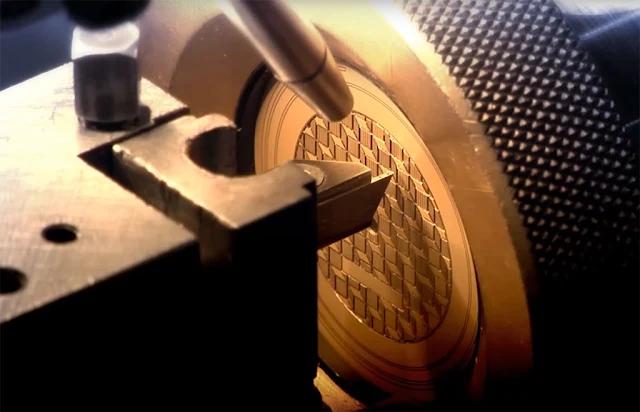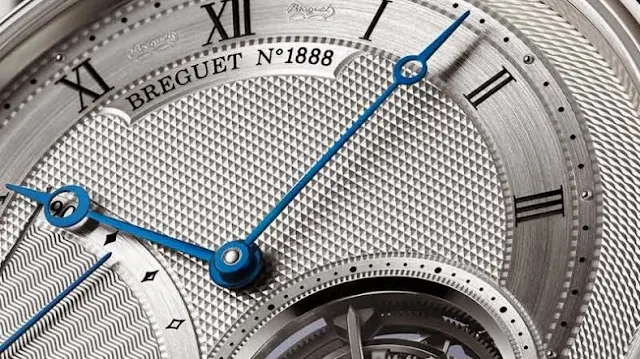The House of Breguet played a fundamental role in the evolution of watchmaking with an impressive number of innovations and inventions.
Also in terms of style Breguet defined a timeless aesthetics that significantly influenced the watchmaking industry and makes each timepiece unmistakably recognizable as a creation of the brand.
Drawing inspiration from the classical rules of proportion and order, the Breguet style is revealed by a number of elements and details that are special to Breguet watches. In this article we describe some of these key elements.
Engine-turned dials
This traditional decoration technique became one of the many distinctive traits of a Breguet timepiece since the very beginning of the history of the brand. Founder Abraham-Louis was the first to introduce guilloché carving for watch dials. Receptive patterns were engraved on the dial plate using a manual lathe. More than merely decorative, these patterns offered the advantage of suppressing the reflection of light on metal dial plates.
Today, Breguet craftsmen still continue to use engine-turning lathes designed and built over a century ago.
With a precision of a tenth of a millimeter, they engrave intricate patterns like clou de Paris hobnailing, pavé de Paris cobbling, sunburst, barleycorn, waves, cross weave, checkerboard, flame and many more. Dexterity and coordination are required: while the left hand slowly rotates the piece to be decorated, with the right hand the guillocheur exerts the proper pressure to engrave it.
Once the dial plate has been meticulously engine-turned by hand, it is silver coated using techniques developed over two centuries ago: powdered silver is delicately brushed on the plate with circular or linear movements, depending on the type of satin-like finish desired.
The same kind of engine-turned guilloché work engraved on gold Breguet dials is also executed on delicate and brittle plates of mother-of-pearl.
Breguet numerals
While Breguet often uses Roman numerals for its guilloché dials, for other models we find graceful Arabic numerals that have become a distinctive trait of the brand.
Designed by Abraham-Louis Breguet himself, these Arabic numerals show the talent of the great watchmaker for combining function with elegance.
Still used on watches with enamel dials, Breguet numerals first appeared before the French Revolution when they shared the dial with tiny stars to mark the minutes and stylised fleur-de-lys at five-minute intervals.
A single number for each watch
Each Breguet watch produced is a special creation that deserves to be identified with a unique number, making it possible to confirm its origin and provenance even after centuries.
Started since the early days of the brand, this tradition is also a proof of the craftsmanship of those who have created it and the attention and care that is spent in its manufacture.
The number is generally positioned just after the logo, in a separate space at 6 o'clock or on the caseback when it is not possible to engrave it on the dial, like for enamel dials or in case of sportier and busier dials.
Lugs
The lugs that Breguet uses for its wristwatches also bear the hallmarks of authentic Breguet styling.
Rather than the usual sprung bars, screw-pins are used to hold the strap between the horns. This solution ensures a better visual result while being more secure.
The distinctive lugs are welded onto the case band both for technical reasons of rigidity and strength and for aesthetic consistency.
These are only some of the most evident design elements that contribute to define the unique Breguet style. The owners of a Breguet timepiece, while wearing it or exploring it with a loupe, learn to appreciate many other refined details that make a Breguet timepiece so elegant and aesthetically pleasing. breguet.com
Suggested reading:
- The history of Breguet
- Our visit to the Breguet Manufacture
Also in terms of style Breguet defined a timeless aesthetics that significantly influenced the watchmaking industry and makes each timepiece unmistakably recognizable as a creation of the brand.
Drawing inspiration from the classical rules of proportion and order, the Breguet style is revealed by a number of elements and details that are special to Breguet watches. In this article we describe some of these key elements.
Engine-turned dials
Today, Breguet craftsmen still continue to use engine-turning lathes designed and built over a century ago.
With a precision of a tenth of a millimeter, they engrave intricate patterns like clou de Paris hobnailing, pavé de Paris cobbling, sunburst, barleycorn, waves, cross weave, checkerboard, flame and many more. Dexterity and coordination are required: while the left hand slowly rotates the piece to be decorated, with the right hand the guillocheur exerts the proper pressure to engrave it.
Once the dial plate has been meticulously engine-turned by hand, it is silver coated using techniques developed over two centuries ago: powdered silver is delicately brushed on the plate with circular or linear movements, depending on the type of satin-like finish desired.
The same kind of engine-turned guilloché work engraved on gold Breguet dials is also executed on delicate and brittle plates of mother-of-pearl.
Breguet hands
Breguet watches have featured its founder’s celebrated hollow, eccentric “moon” tip watch hands for over two centuries now. Designed around 1783, his slim, sleek hands proved an instant success demonstrated by the fact that the term ‘Breguet hands’ soon entered the vocabulary of watchmaking.
The typical hands adorning a guilloché dial of an early Breguet pocket watch - 1786
Made of gold or blued steel, they are simple and easy-to-read and can be found on most Breguet timepieces adding great elegance to a watch.
Caseband fluting
Most Breguet timepieces, especially their dress watches, are enhanced by a refined decoration on the caseband called fluting, a pattern of fine grooves enhanced with double beading.
The fluted pattern is cold-rolled into the case band then finished by hand on a mechanical workpiece-holder.
Depending on the model the fluting can be slightly restyled like it happens for the Marine and Type XX - XXI - XXII lines.
While Breguet often uses Roman numerals for its guilloché dials, for other models we find graceful Arabic numerals that have become a distinctive trait of the brand.
Designed by Abraham-Louis Breguet himself, these Arabic numerals show the talent of the great watchmaker for combining function with elegance.
The Breguet No. 15 watch - 1787
Still used on watches with enamel dials, Breguet numerals first appeared before the French Revolution when they shared the dial with tiny stars to mark the minutes and stylised fleur-de-lys at five-minute intervals.
A single number for each watch
Each Breguet watch produced is a special creation that deserves to be identified with a unique number, making it possible to confirm its origin and provenance even after centuries.
Started since the early days of the brand, this tradition is also a proof of the craftsmanship of those who have created it and the attention and care that is spent in its manufacture.
The number is generally positioned just after the logo, in a separate space at 6 o'clock or on the caseback when it is not possible to engrave it on the dial, like for enamel dials or in case of sportier and busier dials.
Lugs
The lugs that Breguet uses for its wristwatches also bear the hallmarks of authentic Breguet styling.
Rather than the usual sprung bars, screw-pins are used to hold the strap between the horns. This solution ensures a better visual result while being more secure.
The distinctive lugs are welded onto the case band both for technical reasons of rigidity and strength and for aesthetic consistency.
The secret signature
Due to their extraordinary success, Breguet timepieces quickly became a target for counterfeiters. In 1795, Abraham-Louis Breguet found a way to make counterfeiting very difficult: his secret signature.
Etched into the dial, the signature is all but invisible unless the dial is examined in oblique light. Still a token of authenticity, the secret signature has remained a feature of many Breguet dials till our days.
Suggested reading:
- The history of Breguet
- Our visit to the Breguet Manufacture



























